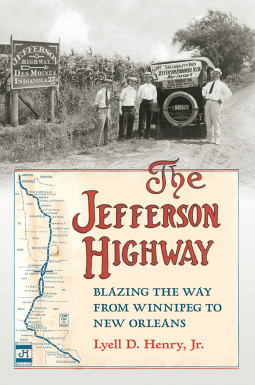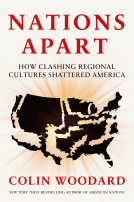
The Jefferson Highway
Blazing the Way from Winnepeg to New Orleans
by Lyell D., Jr. Henry
This title was previously available on NetGalley and is now archived.
Send NetGalley books directly to your Kindle or Kindle app
1
To read on a Kindle or Kindle app, please add kindle@netgalley.com as an approved email address to receive files in your Amazon account. Click here for step-by-step instructions.
2
Also find your Kindle email address within your Amazon account, and enter it here.
Pub Date Apr 15 2016 | Archive Date Jun 01 2016
University of Iowa Press | University Of Iowa Press
Description
The plight of the rapidly rising numbers of early motorists soon spawned a “good roads” movement that included many efforts to build and pave long-distance, colorfully named auto trails across the length and breadth of the nation. Full of a can-do optimism, these early partisans of motoring sought to link together existing roads and then make them fit for automobile driving—blazing, marking, grading, draining, bridging, and paving them. The most famous of these named highways was the Lincoln Highway between New York City and San Francisco. By early 1916, a proposed counterpart coursing north and south from Winnipeg to New Orleans had also been laid out.
Called the Jefferson Highway, it eventually followed several routes through Minnesota, Iowa, Missouri, Kansas, Oklahoma, Texas, Arkansas, and Louisiana. The Jefferson Highway, the first book on this pioneering road, covers its origin, history, and significance, as well as its eventual fading from most memories following the replacement of names by numbers on long-distance highways after 1926. Saluting one of the most important of the early named highways on the occasion of its 100th anniversary, historian Lyell D. Henry Jr. contributes to the growing literature on the earliest days of road-building and long-distance motoring in the United States. For readers who might also want to drive the original route of the Jefferson Highway, three chapters trace that route through Iowa, pointing out many vintage features of the roadside along the way. The perfect book for a summer road trip!
Advance Praise
“Travelers wise enough to shun the monotonous, crowded turnpikes and interstates must read this well-researched book. They will discover that the Jefferson Highway—the first international highway traversing the United States from north to south through the Mississippi Valley—is alive and well, especially in Iowa, where a century ago the brainchild of a Des Moines publisher became a reality.”— Michael Wallis, author, Route 66: The Mother Road
“Despite their importance, the old named auto ‘trails’ are largely forgotten. Historian Lyell Henry has turned his formidable talents to one of the most influential, the Pine to Palm road from Winnipeg to New Orleans. Anyone embarking upon his Jefferson Highway is in for a splendid ride!”—Max J. Skidmore, author, Moose Crossing: Portland to Portland on the Theodore Roosevelt International Highway
Available Editions
| EDITION | Other Format |
| ISBN | 9781609384210 |
| PRICE | $29.95 (USD) |
Links
Average rating from 11 members
Featured Reviews
 David W, Media/Journalist
David W, Media/Journalist
The reason I wanted to read The Jefferson Highway was for a breath of fresh air. It was such a totally different time. Roads were dirt trails. Highways had names, not numbers. They passed right through town, benefitting everyone. The very thought of a single highway running from Winnipeg to New Orleans got everyone so excited they donated money, gravel, and labor. Coordinating everyone from end to end was a massive undertaking. Townspeople came together to ensure they were part of it all. Fundraising for highways was an honor. When a hotel or gas station opened along the way, it was cause for celebration. Today, highways go literally out of their way to bypass towns. Funding is measured and federal, services few and far between. And highways are numbers.
The Jefferson Highway was the complement to the Lincoln Highway, which ran east-west, from New York to San Francisco. They crossed in Colo, Iowa, the geographic center of the country. The book is largely about how it all transpired in Iowa, but the same sorts of events took place the length of the highway. It was exciting, consuming, and worthwhile.
This was not a six lane, concrete interstate; gravel was a miracle upgrade in some of the stretches. And it wasn’t a straight shot. There were curves, turns and street changes all along. The highway was marked by a JH logo on poles and posts so you would know you were still on it. Fortunately, there is an interactive map available (ironically) the highway’s website, so you can zoom in and see exactly what Lyell Henry is describing.
So while I have little interest the street names, gas stations, campgrounds and hotels of central Iowa, The Jefferson Highway is a minor treat.
David Wineberg
 Jeffrey W, Reviewer
Jeffrey W, Reviewer
The Jefferson Highway by Lyell D. Henry Jr, was received direct from the publisher in exchange for an honest review. To start out on the right foot, I do enjoy some historical books. With this one, the author tended to be thorough, at times overly thorough, leading to skimming. The Jefferson Highway, if you cant tell from the title, led from Winnipeg to New Orleans, with some parts of it unknown in this day and age. The book explored how local politics were the largest factor in deciding road routes back when roads for automobiles was not common. I enjoyed the parts of the book about the early highway system in general, such as how disabled people were some of the first to embrace the highway system and how traveling salesmen moved from trains to the highways. This was after transportation via automobile got more reliable. Lastly, prior t motels and rest stops, there were FREE tourist camps, which didn't not last many years and quickly turned into what are now motels. If these topics interest you or someone you know, certainly obtain this book.
 Bonnye Reed F, Reviewer
Bonnye Reed F, Reviewer
I received a free electronic copy of this book from Netgalley and Lyell D. Henry, Jr, in exchange for an honest review. Thank you for sharing your work with me. I look forward to an entertaining and educational read. The amount of research that has gone into this history of the Jefferson Highway is impressive.
The growth and expansion of our federal highway systems has aways facinated me, and this remarkable book, easy to read with appealing details as one travels down the road, is enough to stir ideas of Yankee-land wanderings in a strictly Southern soul.
Prior to reading this excellent history of the Jefferson Highway and tour guide of Iowa, if I thought of Iowa at all, it was the farm-lined state through which one had to travel to get from a cousin's place in Missouri to a friend's home in Wisconsin. I am now planning a trip to follow the Jefferson Highway from Wisconsin through Iowa and wander on down to New Orleans. Thank you Lyell D. Henry, Jr. For opening up this perspective for me. Though my travels will continue to be heavy on the Southern side, I would really like to see the Iowa presented in this book.
 Marie S, Reviewer
Marie S, Reviewer
A very interesting book to read on a stretch of the American Highway system called the Jeffereson Highway. I like these type of books but I will admit this one was more on the dry side of reading. But it was still good and informative so I still recommend it highly.
Readers who liked this book also liked:
Noam Chomsky; José Mujica; Saúl Alvídrez
Essays & Collections, Multicultural Interest, Politics & Current Affairs


















